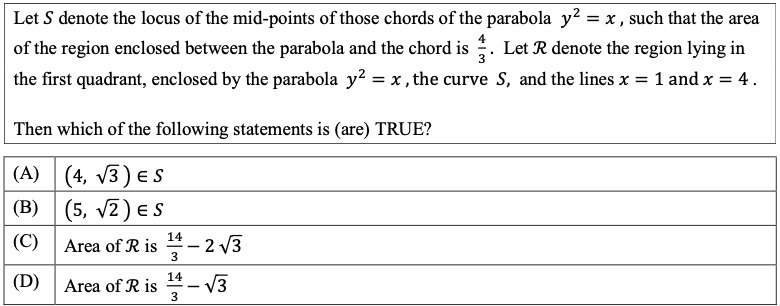Question
Question: Let $S$ denote the locus of the mid-points of those chords of the parabola $y^2 = x$, such that the ...
Let S denote the locus of the mid-points of those chords of the parabola y2=x, such that the area of the region enclosed between the parabola and the chord is 34. Let R denote the region lying in the first quadrant, enclosed by the parabola y2=x, the curve S, and the lines x=1 and x=4.
Then which of the following statements is (are) TRUE?

(4,3)∈S
(5,2)∈S
Area of R is 314−23
Area of R is 314−3
(A), (C)
Solution
Let the parabola be y2=x. Let M(h,k) be the midpoint of a chord of the parabola. The equation of the chord with midpoint (h,k) is given by T=S1, where S=y2−x.
yk−21(x+h)=k2−h 2yk−x−h=2k2−2h x=2yk−2k2+h.
The area of the region enclosed between the parabola y2=x and the chord x=2yk−2k2+h is given by integrating with respect to y. The intersection points of the parabola and the chord are found by substituting x=y2 into the chord equation:
y2=2yk−2k2+h y2−2ky+(2k2−h)=0.
Let the roots of this quadratic equation in y be y1 and y2. These are the y-coordinates of the intersection points. From Vieta's formulas, y1+y2=2k and y1y2=2k2−h. The area between the parabola x=y2 and the chord is given by the integral ∫y1y2(xline−xparabola)dy.
Area =∫y1y2(2yk−2k2+h−y2)dy. The integrand is −(y2−2ky+2k2−h), which can be written as −(y−y1)(y−y2). The value of the integral ∫y1y2−(y−y1)(y−y2)dy is 61(y2−y1)3. We are given that this area is 34.
61(y2−y1)3=34 (y2−y1)3=6×34=8 ∣y2−y1∣=2. Assuming y2>y1, we have y2−y1=2.
We have the system of equations: y1+y2=2k y2−y1=2
Adding the two equations gives 2y2=2k+2, so y2=k+1. Subtracting the second equation from the first gives 2y1=2k−2, so y1=k−1.
Now use the product of roots: y1y2=2k2−h. (k−1)(k+1)=2k2−h k2−1=2k2−h h=2k2−k2+1=k2+1. Let (h,k)=(x,y). The locus of the midpoints S is given by the equation x=y2+1.
Let's check the given statements about S: (A) (4,3)∈S? Substitute x=4,y=3 into x=y2+1: 4=(3)2+1=3+1=4. This is true. So (4,3)∈S. (B) (5,2)∈S? Substitute x=5,y=2 into x=y2+1: 5=(2)2+1=2+1=3. This is false. So (5,2)∈/S.
Now consider the region R. R is in the first quadrant, enclosed by the parabola y2=x (or x=y2), the curve S (x=y2+1), and the lines x=1 and x=4.
The region R is the set of points (x,y) in the first quadrant such that 1≤x≤4 and y2≤x≤y2+1. This means y2≤x and x≤y2+1. Combining with 1≤x≤4: 1≤x≤min(4,y2+1) and max(1,y2)≤x≤4. The condition y2≤x≤y2+1 means the region is between the two parabolas. The condition 1≤x≤4 means the region is between the vertical lines.
Let's integrate with respect to x. Area R=∫14(yupper−ylower)dx.
From y2≤x, we get y≤x (since y≥0). From x≤y2+1, we get y2≥x−1, so y≥x−1 (since y≥0). So the region is 1≤x≤4 and x−1≤y≤x. Area R=∫14(x−x−1)dx. Area R=∫14x1/2dx−∫14(x−1)1/2dx. ∫x1/2dx=3/2x3/2=32x3/2. ∫(x−1)1/2dx=3/2(x−1)3/2=32(x−1)3/2. Area R=[32x3/2]14−[32(x−1)3/2]14. Area R=(32(4)3/2−32(1)3/2)−(32(4−1)3/2−32(1−1)3/2). Area R=(32(8)−32(1))−(32(3)3/2−32(0)3/2). Area R=(316−32)−(32(33)−0). Area R=314−23.
Let's check the statements about the area of R: (C) Area of R is 314−23. This is TRUE. (D) Area of R is 314−3. This is FALSE.
The correct statements are (A) and (C).
